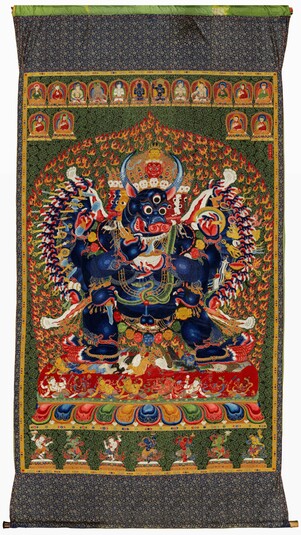
Item: Vajrabhairava (Buddhist Deity) - Solitary (Ekavira)
| Origin Location | China |
|---|---|
| Date Range | 1400 - 1499 |
| Lineages | Gelug and Buddhist |
| Size | 300cm (118.11in) high |
| Material | Ground: Textile Image, Embroidery |
| Collection | Private |
Classification: Deity
Appearance: Animal-Feature
Gender: Male
Ekavira Vajrabhairava (Tibetan: dor je jig je pa wo chig pa. English: The Solitary Hero Vajra Terror) a wrathful form of Manjushri.
Bhairava, dark blue in colour, has 9 faces, 34 hands and 16 legs. The main face is that of a buffalo, with a red face above and the slightly angry yellow face of Manjushri placed on top. Flames shoot from the tips of the horns. The three right faces are yellow, blue and red and the three left are black, white and smoky. Each face has three large round eyes, bared fangs and frightful expressions; brown hair flows upward like flames. The first pair of hands hold a curved knife and skullcup to the heart. The remaining hands hold a multitude of weapons with the 2nd and last set holding in addition the fresh outstretched hide of an elephant. He is adorned with bracelets, necklaces and a girdle all formed of interlaced bone ornaments, a necklace of snakes and a long necklace of fifty heads. The right legs are bent pressing down on a man, animals and various gods. The left legs are extended straight and press upon eight birds and various gods; standing above a sun disc and multi-coloured lotus completely surrounded by the orange flames of pristine awareness. To each side of the lotus throne skullcups are filled with various offerings.
Along the top of the composition are the lineage teachers from India, Nepal and Tibet.
As a meditational deity Vajrabhairava, also known as Yamantaka, belongs to the Vajrabhairava and Yamari class of tantras and specifically arises from the Vajra Bhairava Root Tantra (Tibetan: jig je tsa gyu). All of those belong to the method (father) classification of Anuttaryoga Tantra. The practice of Bhairava is common to the three Sarma Schools: Sakya, Kagyu and Gelugpa. Among the Sakya it is counted as one of the four main tantric deities. There are numerous forms and styles of practice from the very complex with numerous deities to the very concise with a single Heruka form. The main lineages to enter Tibet were those of Jowo Atisha, Rwa Lotsawa, Mal Lotsawa and the like.
This form of Vajrabhairava with the central faces placed 3 vertically and 3 faces to each side arranged horizontally is unique to the Gelugpa School and true to a visionary experience of Lord Tsongkapa the founder.
Lineage: Shri Vajrabhairava, Jnana Dakini, Mahasiddha Lalitavajra, Amoghavajra, Yeshe Jungne Bepa, Mahasiddha Padmavajra, Marmedze Srungwa, Rwa Lotsawa Dorje Drag, Rwa Chorab, Rwa Yeshe Sengge, Rwa Bum Seng, Rongpa Gwalo Namgyal Dorje, Rongpa Sherab Sengge, Lamdrepa Yeshe Palwa, Je Sonam Lhundrub, Choje Dondrup Rinchen, Je Tsongkapa Lobzang Dragpa (1357-1419), etc.
Jeff Watt 9-2014
Textile: Woven Artwork Main Page
Buddhist Deity: Vajrabhairava (Textile Masterworks)
Subject: Art History Number Sets
Textile: Masterworks (纺织品, འཐག་དྲུབ་མ།)
Buddhist Deity: Vajrabhairava Main Page
Textile: Main Page
Subject: Yongle Textile Workshop Discussion
Subject: Yongle Textile Workshop Discussion (Chinese Translation)
Buddhist Deity: Vajrabhairava (Early Works, Painting & Textile)
Buddhist Deity: Vajrabhairava (Textiles)
Subject: Yongle Brocade Textiles


